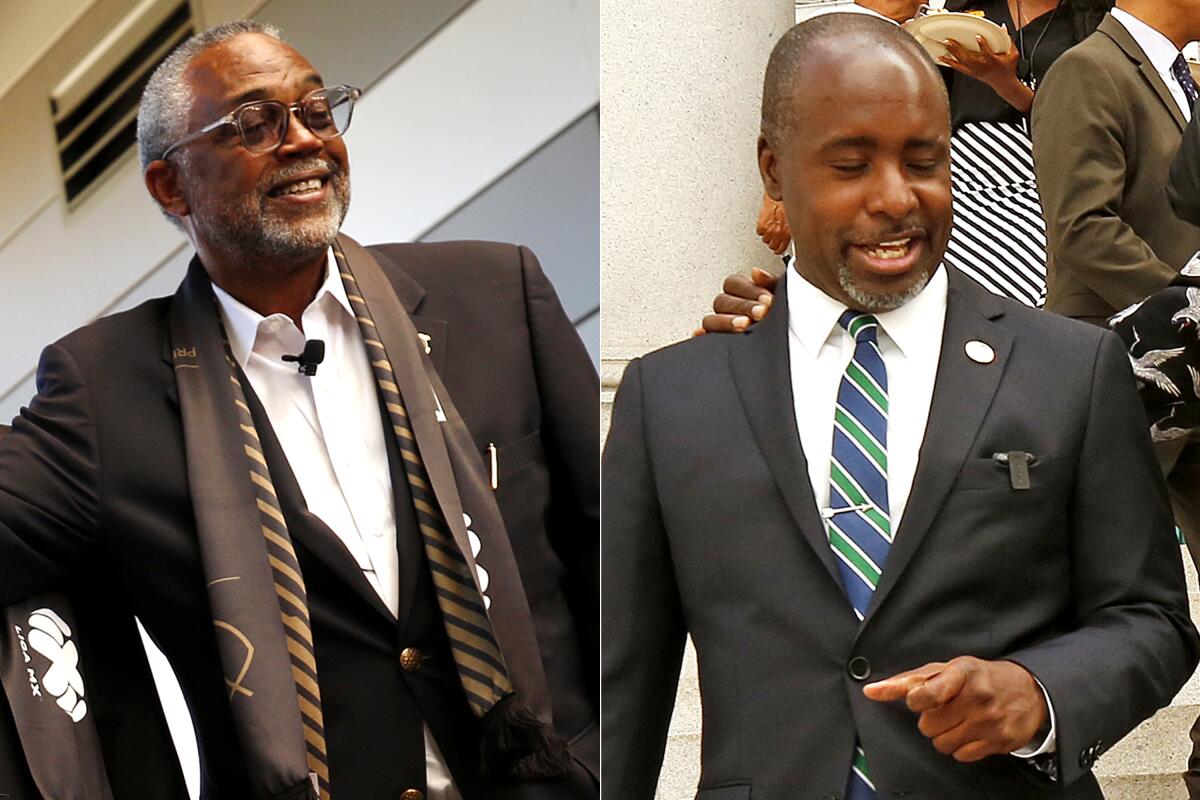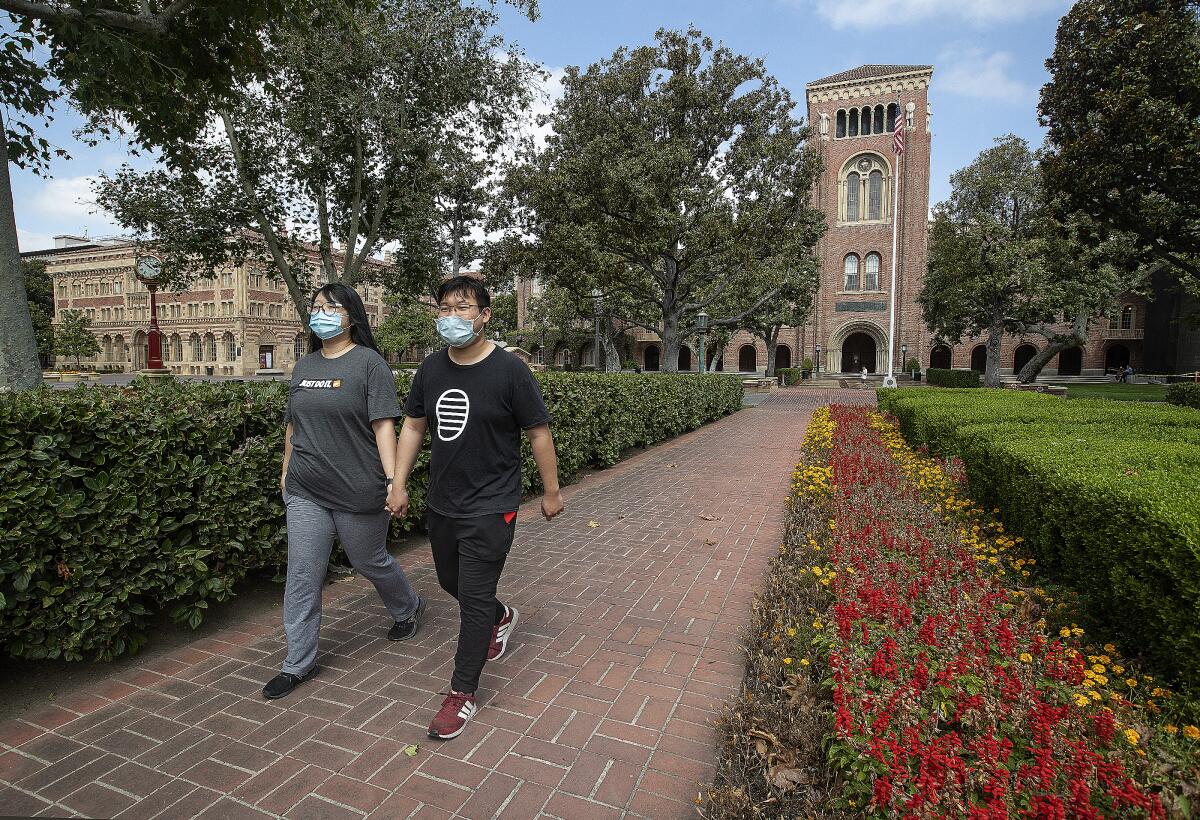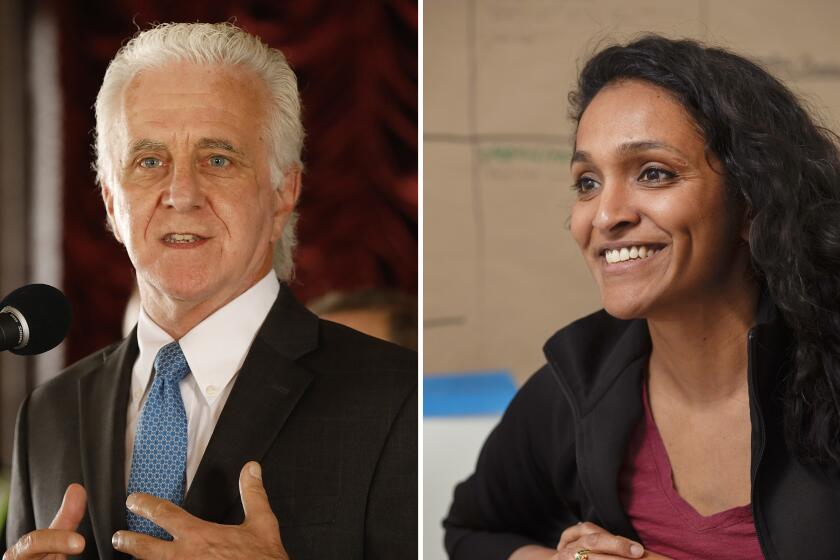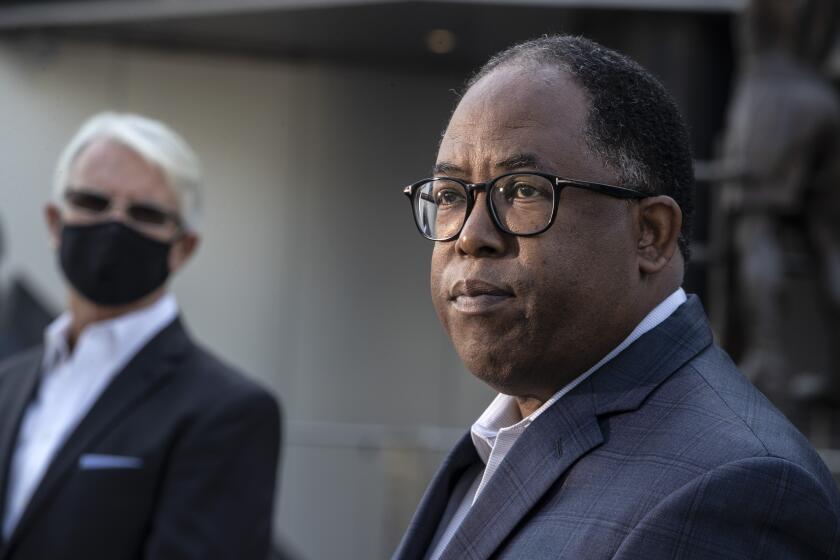Two L.A. council members fight over who gets USC as redistricting heats up

- Share via
It would have been enough for the University of Southern California to find itself at the center of one political controversy this month — a federal indictment targeting a former dean and Los Angeles City Councilman Mark Ridley-Thomas.
But now USC has been drawn into a second political skirmish at City Hall: a tug of war between two other council members, each of whom has expressed interest in representing USC.
The city’s Redistricting Commission, charged with redrawing council district boundaries, brought the issue to a head Monday night, voting 11 to 10 to move USC out of Councilman Curren Price’s district and into the one represented by Councilman Marqueece Harris-Dawson. On Tuesday night, they abruptly reversed themselves, shifting USC back into Price’s district on an 11 to 9 vote.
Harris-Dawson’s supporters have argued that moving USC, along with nearby museums and stadiums, back into the 8th District after a 10-year absence would correct a serious injustice. The council shifted those institutions out of the 8th, which has the largest percentage of Black residents in the city, during the last redistricting in 2012.
Price and his allies say they are determined to keep billion-dollar assets from being pulled out of the 9th District, describing them as essential to the area’s economic prosperity. The existing district, which is 78% Latino, has the largest concentration of residents living in poverty anywhere in the city, according to figures supplied by redistricting commission officials.
The draft map would dramatically redesign City Council districts represented by Paul Krekorian and Nithya Raman.
The commission meets Thursday to finalize its map, which will be considered by the council later this year. But this week’s votes have increased the chances of a messy skirmish involving Price and Harris-Dawson, both of whom are Black and represent different sections of South Los Angeles.
A relocation of the university also could become a campaign issue for Price, who is running for reelection. One of his opponents, Dulce Vasquez, has already begun demanding that USC stay put.
The question of USC has been percolating for months. Harris-Dawson took on the issue three weeks ago, saying on Twitter that USC and several other “economic assets” — the Los Angeles Memorial Coliseum, the California African American Museum, among others — had been stripped from his district a decade ago and should be returned.
Community Coalition, a nonprofit that Harris-Dawson ran before taking office, took a similar stand. And on Monday, Harris-Dawson’s appointee on the Redistricting Commission, Valerie Shaw, demanded an up-or-down vote from the 21-member commission, calling the return of USC a civil rights issue.
Shaw predicted that, because of changing demographics, Harris-Dawson’s district would eventually become “the only venue through which African Americans will have a voice in this city.”

“The future of the African-American community lies” with the 8th District, she said. “So this vote is about the future of Black folks in L.A..”
Harris-Dawson’s 8th district is currently 33% Black and nearly 58% Latino, population figures show. However, among voting-age citizens in his district, Black residents still make up the majority, according to redistricting figures.
Price responded to the commission’s initial vote, taken Monday, by calling it a “power grab of monumental proportions.” Taking USC and other institutions out of his district, he warned, would “directly contribute to the decline of a Black and brown community that has been on the rise.”
Price’s 9th District stretches from 95th Street north to Staples Center in downtown Los Angeles. Among the district’s voting-age residents who are also citizens, about 64% are Latino and 25% are Black, according to redistricting figures.
“This fight is not over,” Price said in a statement. “I will fight tooth and nail to keep our district whole and defend it to the very end.”
Asked about the controversy, USC officials did not say whether the university would prefer one district or the other. Samuel Garrison, USC senior vice president of university relations, said only that the University Park neighborhood, which includes USC, should be kept in a single district.
“We have made great strides together in recent years, and we want to build on the collaborations and partnerships over the next decade,” he said in a statement. “Dividing University Park up into two districts would be a step backwards and jeopardize the progress we have made as a community.”
For many voters, major institutions like USC are viewed as a boon for an entire region, not just a single City Council district. However, there can be situations where a district could receive focused support.
When colleges, museums and real estate developers propose construction projects in L.A., they may work with their council representative to determine how some of the project’s economic benefits might be distributed.
Charisse Bremond Weaver, a redistricting commissioner appointed by Mayor Eric Garcetti, argued in favor of a compromise this week, proposing that Price’s district receive USC while having Harris-Dawson’s district take in museums near the university. On Tuesday, the commission agreed to put Exposition Park, located next to USC, in Harris-Dawson’s district.
The debate over who should represent USC is only one issue percolating in the redistricting process. Council members Paul Krekorian and Nithya Raman have complained for weeks that their districts are being redrawn in a way that could cause them to lose many of the neighborhoods that elected them last year.
Already unsettled by the likely departure of the mayor, an upcoming election and a contentious redistricting process, the City Council must decide what to do about Councilman Mark Ridley-Thomas.
The map-drawing process has coincided with the recent filing of a criminal indictment against Ridley-Thomas and a former USC dean, which alleges they conspired to steer county money to the university in return for admission of Ridley-Thomas’ son into graduate school with a full-tuition scholarship and a paid professorship.
Ridley-Thomas, a former county supervisor who also represents part of South Los Angeles, has vowed to fight the charges. A lawyer for Marilyn Louise Flynn, the former USC dean, said her client has not committed any crime.
The city redraws council district boundaries every 10 years, after the release of data from the U.S. census. Under that process, city leaders must ensure that each district has roughly the same number of people, while also ensuring that the voting rights of certain groups — including Blacks and Latinos — are protected.
The debate over USC dates from 2011 and 2012, when then-Council President Herb Wesson presided over the redistricting process. At that time, appointees of Wesson, then-Mayor Antonio Villaraigosa and then-Councilman Jose Huizar formed a voting bloc on the redistricting commission, working in tandem to reshuffle the assets of South Los Angeles.
The group voted to take the vast majority of downtown out of Councilwoman Jan Perry’s district, giving it to Huizar, and moved USC out of Councilman Bernard C. Parks’ district and into Perry’s. Perry left office in 2013 and was replaced by Price. Parks left office in 2015 and was replaced by Harris-Dawson.
Parks and Perry said at the time that they were being punished by Wesson, with whom they had been at odds. Wesson, in turn, denied that that was the case.
On Tuesday, Bernard Parks Jr., a son of the former councilman, said he was amused to hear Harris-Dawson and his allies objecting to the removal of USC and other institutions from the 8th District during the 2012 redistricting.
“I’m curious to know where he was 10 years ago, when he was a supposed community activist,” said Parks Jr., who worked in his father’s council office for a dozen years.
Rhonda Mitchell, a spokeswoman for Harris-Dawson, said her boss would not respond to those remarks. Harris-Dawson also declined to discuss the ongoing debate over USC.
“At this time, the council member has nothing to add to the conversation,” she said.
More to Read
Sign up for Essential California
The most important California stories and recommendations in your inbox every morning.
You may occasionally receive promotional content from the Los Angeles Times.













